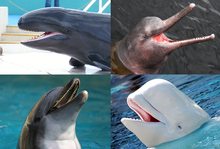
Back حيتان مسننة Arabic حيتان مسننه ARZ Dişli balinalar Azerbaijani Зубатыя кіты Byelorussian Зубатыя кіты BE-X-OLD Зъбати китове Bulgarian Morvil dantek Breton Odontocets Catalan Odontoceti CEB Ozubení Czech
| Toothed whales | |
|---|---|

| |
| Clockwise from top left: false killer whale, Amazon river dolphin, beluga, and bottlenose dolphin | |
| Scientific classification | |
| Domain: | Eukaryota |
| Kingdom: | Animalia |
| Phylum: | Chordata |
| Class: | Mammalia |
| Order: | Artiodactyla |
| Infraorder: | Cetacea |
| Parvorder: | Odontoceti Flower, 1867 |
| Subgroups | |
| |
| Diversity | |
| Around 73 | |
The toothed whales (also called odontocetes, systematic name Odontoceti) are a clade of cetaceans that includes dolphins, porpoises, and all other whales with teeth, such as beaked whales and the sperm whales. 73 species of toothed whales are described. They are one of two living groups of cetaceans, the other being the baleen whales (Mysticeti), which have baleen instead of teeth. The two groups are thought to have diverged around 34 million years ago (mya).
Toothed whales range in size from the 1.4 m (4 ft 7 in) and 54 kg (119 lb) vaquita to the 20 m (66 ft) and 100 t (98 long tons; 110 short tons) sperm whale. Several species of odontocetes exhibit sexual dimorphism, in that there are size or other morphological differences between females and males. They have streamlined bodies and two limbs that are modified into flippers. Some can travel at up to 30 knots. Odontocetes have conical teeth designed for catching fish or squid. They have well-developed hearing that is well adapted for both air and water, so much so that some can survive even if they are blind. Some species are well adapted for diving to great depths. Almost all have a layer of fat, or blubber, under the skin to keep warm in the cold water, with the exception of river dolphins.
Toothed whales consist of some of the most widespread mammals, but some, as with the vaquita, are restricted to certain areas. Odontocetes feed largely on fish and squid, but a few, like the orca, feed on mammals, such as pinnipeds. Males typically mate with multiple females every year, making them polygynous. Females mate every two to three years. Calves are typically born in the spring and summer, and females bear the responsibility for raising them, but more sociable species rely on the family group to care for calves. Many species, mainly dolphins, are highly sociable, with some pods reaching over a thousand individuals.
Once hunted for their products, cetaceans are now protected by international law. Some species are very intelligent. At the 2012 meeting of the American Association for the Advancement of Science, support was reiterated for a cetacean bill of rights, listing cetaceans as nonhuman persons. Besides whaling and drive hunting, they also face threats from bycatch and marine pollution. The baiji, for example, is considered functionally extinct by IUCN, with the last sighting in 2004, due to heavy pollution to the Yangtze River. Whales sometimes feature in literature and film, as in the great white sperm whale of Herman Melville's Moby-Dick. Small odontocetes, mainly dolphins, are kept in captivity and trained to perform tricks. Whale watching has become a form of tourism around the world.